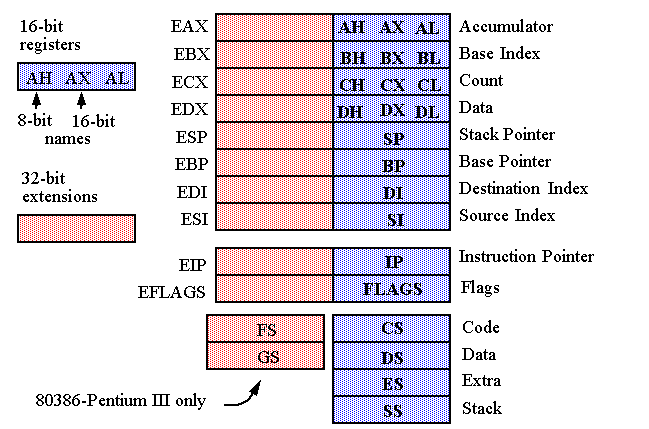-
Outline:
-
Internal
programmer visible
architecture, e.g. registers
-
Real Mode Addressing:
-
Real Mode Memory: 00000H-FFFFFH (the first 1MB of main memory).
-
Protected Mode Addressing:
-
All of memory (applicable to 80286 and later processors).
-
Programmer
in
visible
registers to control and operate the protected memory system.
-
Programmer visible registers:
-
General Purpose Registers: The main functions are listed.
-
EAX: Accumulator
: Referenced as EAX, AX, AL or AH.
-
Used for mult, div, etc.
-
Used to hold an offset.
-
EBX: Base Index
:
-
Used to hold the offset of a data pointer.
-
ECX: Count
:
-
Used to hold the count for some instructions, REP and LOOP.
-
Used to hold the offset of a data pointer.
-
EDX: Data
:
-
Used to hold a portion of the result for mult, of the operand for div.
-
Used to hold the offset of a data pointer.
-
EBP: Base Pointer
:
-
Holds the base pointer for memory data transfers.
-
EDI: Destination Index
:
-
Holds the base destination pointer for string instructions.
-
ESI: Source Index
:
-
Holds the base source pointer for string instructions.
-
Special Purpose Registers:
-
EIP: Instruction Pointer
:
-
Points to the next instruction in a code segment.
-
16-bits (IP) in real mode and 32-bits in protected mode.
-
ESP: Stack Pointer
:
-
Used by the stack, call and return instructions.
-
EFLAGS
:
-
Store the state of various conditions in the microprocessor.
-
Special Purpose Registers:
-
The rightmost 5 flag bits and overflow change after many of the arithmetic and logic instructions execute. Data transfer and control instructions never change the flags.
-
C (Carry)
:
-
Holds the carry out after addition or the borrow after subtraction.
-
Also indicates error conditions.
-
P (Parity)
:
-
0 for odd number of bits and 1 for even.
-
Obsolete feature of the 80x86.
-
A (Auxiliary Carry)
:
-
Highly specialized flag used by DAA and DAS instructions after BCD addition or subtraction.
-
Special Purpose Registers:
-
EFLAGS
(cont).
-
Z (Zero)
:
-
1 if the result of an arithmetic or logic instruction is 0.
-
S (Sign)
:
-
1 if the sign of the result of an arith. or logic instruction is negative.
-
T (Trap)
:
-
Trap enable. The microprocessor interrupts the flow of instructions on conditions indicated by the debug and control registers.
-
I (Interrupt)
:
-
Controls the operation of the INTR (Interrupt request) pin. If 1, interrupts are enabled. Set by
STI
and
CLI
instructions.
-
D (Direction)
:
-
Selects with increment or decrement mode for the DI and/or SI registers during string instructions. If 1, registers are automatically decremented. Set by
STD
and
CLD
instructions.
-
O (Overflow)
:
-
Set for addition and subtraction instructions.
-
Special Purpose Registers:
-
EFLAGS
(cont).
-
80286 and up:
-
IOPL (I/O privilege level)
:
-
It holds the privilege level at which your code must be running in order to execute any I/O-related instructions. 00 is the highest.
-
NT (Nested Task)
:
-
Set when one system task has invoked another through a CALL instruction in protected mode.
-
80386 and up:
-
RF (Resume)
:
-
Used with debugging to selectively mask some exceptions.
-
VM (Virtual Mode)
:
-
When 0, the CPU can operate in Protected mode, 286 Emulation mode or Real mode. When set, the CPU is converted to a high speed 8086. This bit has enormous impact.
-
Special Purpose Registers:
-
EFLAGS
(cont).
-
80486SX and up:
-
AC (Alignment Check)
:
-
Specialized instruction for the 80486SX.
-
Pentium and up:
-
VIF (Virtual Interrupt Flag)
:
-
Copy of the interrupt flag bit.
-
VIP (Virtual Interrupt Pending)
:
-
Provides information about a virtual mode interrupt.
-
ID (Identification)
:
-
Supports the CPUID instruction, which provides version number and manufacturer information about the microprocessor.
-
Segment Registers:
-
CS (Code Segment)
:
-
In real mode, this specifies the start of a 64KB memory segment.
-
In protected mode, it selects a descriptor.
-
The code segment is limited to 64KB in the 8086-80286 and 4 GB in the 386 and above.
-
DS (Data Segment)
:
-
Similar to the CS except this segment holds data.
-
ES (Extra Segment)
:
-
Data segment used by some string instructions to hold destination data.
-
SS (Stack Segment)
:
-
Similar to the CS except this segment holds the stack.
-
ESP and EBP hold offsets into this segment.
-
FS and GS
: 80386 and up.
-
Allows two additional memory segments to be defined.
-
Only mode available to the 8086 and 8088.
-
Allow the processor to address only the first 1MB of memory.
-
DOS requires real mode.
-
Segments and Offsets
:
-
Effective address = Segment address + an offset.
-
Segments and Offsets
:
-
Syntax is usually given as
seg_addr:offset
, e.g.
1000:F000
in the previous example to specify
1F000H
.
-
Implicit combinations of segment registers and offsets are defined for memory references.
-
For example, the code segment (CS) is always used with the instruction pointer (IP for real mode or EIP for protected mode).
-
CS:EIP
-
SS:ESP
,
SS:EBP
-
DS:EAX
,
DS:EBX
,
DS:ECX
,
DS:EDX
,
DS:EDI
,
DS:ESI
,
DS:8-bit_literal
,
DS:32-bit_literal
-
ES:EDI
-
FS
and
GS
have no default.
-
It is illegal to place an offset larger than FFFF into the 80386 32-bit registers operating in Real Mode.
-
Segmented addressing allows relocation of data and code.
-
OS can assign the segment addresses at run time.

